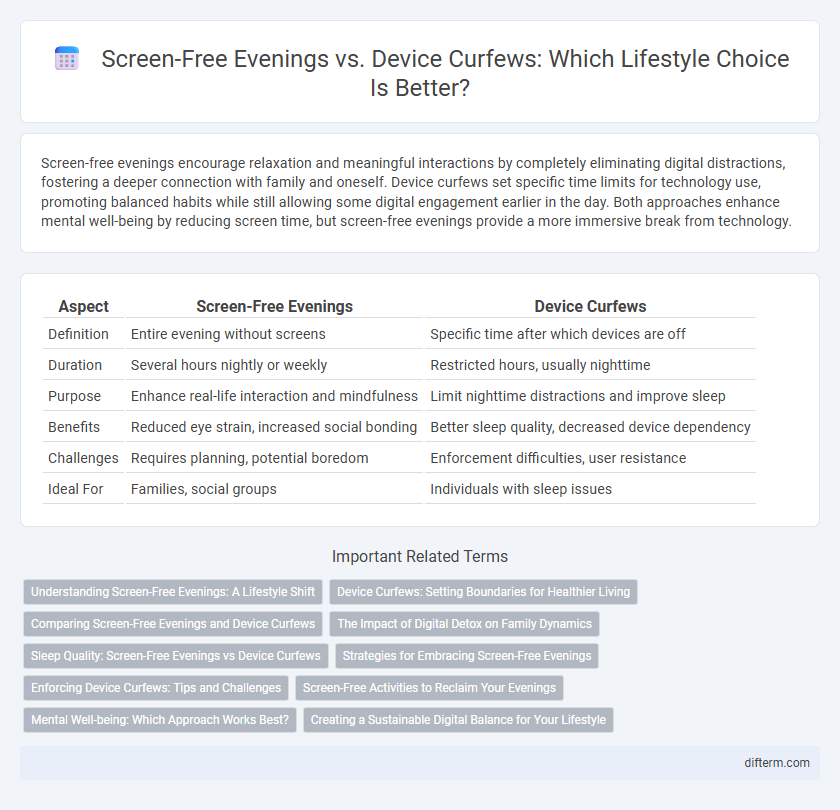Screen-free evenings encourage relaxation and meaningful interactions by completely eliminating digital distractions, fostering a deeper connection with family and oneself. Device curfews set specific time limits for technology use, promoting balanced habits while still allowing some digital engagement earlier in the day. Both approaches enhance mental well-being by reducing screen time, but screen-free evenings provide a more immersive break from technology.
Table of Comparison
| Aspect | Screen-Free Evenings | Device Curfews |
|---|---|---|
| Definition | Entire evening without screens | Specific time after which devices are off |
| Duration | Several hours nightly or weekly | Restricted hours, usually nighttime |
| Purpose | Enhance real-life interaction and mindfulness | Limit nighttime distractions and improve sleep |
| Benefits | Reduced eye strain, increased social bonding | Better sleep quality, decreased device dependency |
| Challenges | Requires planning, potential boredom | Enforcement difficulties, user resistance |
| Ideal For | Families, social groups | Individuals with sleep issues |
Understanding Screen-Free Evenings: A Lifestyle Shift
Screen-free evenings foster improved mental well-being by reducing digital eye strain and promoting quality face-to-face interactions. Embracing this lifestyle shift encourages mindfulness and better sleep patterns without relying solely on device curfews. Prioritizing uninterrupted family time and outdoor activities strengthens social bonds and enhances overall life satisfaction.
Device Curfews: Setting Boundaries for Healthier Living
Device curfews establish specific times to power down smartphones, tablets, and computers, reducing blue light exposure and promoting better sleep quality. Enforcing nightly cut-offs helps minimize digital distractions, supporting mental well-being and lower stress levels. Research shows consistent device curfews improve circadian rhythms and enhance overall lifestyle balance.
Comparing Screen-Free Evenings and Device Curfews
Screen-free evenings promote complete disconnection from digital devices, fostering mindfulness and deeper interpersonal connections, while device curfews limit usage during specific hours, balancing accessibility with reduced screen time. Studies show screen-free evenings significantly improve sleep quality and reduce stress, whereas device curfews primarily mitigate late-night distractions. Choosing between the two depends on lifestyle needs, with screen-free evenings offering total digital detox and device curfews providing flexible technology boundaries.
The Impact of Digital Detox on Family Dynamics
Screen-free evenings foster meaningful interactions and improve emotional bonds within families by reducing distractions and encouraging face-to-face communication. Device curfews establish boundaries that promote healthier sleep patterns and reduce conflicts related to screen time management. Both approaches significantly enhance family dynamics by creating opportunities for shared activities and fostering mutual understanding.
Sleep Quality: Screen-Free Evenings vs Device Curfews
Screen-free evenings significantly improve sleep quality by reducing exposure to blue light that disrupts melatonin production, allowing for more restful and longer sleep cycles. Device curfews help limit screen time, but residual exposure shortly before bed can still impair deep sleep stages and delay sleep onset. Prioritizing entirely screen-free periods before bedtime enhances circadian rhythm alignment and overall restorative sleep.
Strategies for Embracing Screen-Free Evenings
Creating screen-free evenings involves establishing tech-free zones and engaging in activities like reading, cooking, or outdoor walks to reduce digital dependency. Setting a consistent device curfew, such as turning off screens an hour before bedtime, helps improve sleep quality by minimizing blue light exposure. Incorporating mindful practices like journaling or meditation during these periods enhances mental clarity and fosters a balanced lifestyle.
Enforcing Device Curfews: Tips and Challenges
Enforcing device curfews requires establishing consistent boundaries and clear communication to reduce screen time effectively. Challenges include overcoming resistance from family members accustomed to late-night usage and managing the temptation of hidden devices. Strategies such as creating device-free zones and using apps that limit screen access can support adherence to curfews and promote healthier lifestyle habits.
Screen-Free Activities to Reclaim Your Evenings
Engaging in screen-free activities such as reading, journaling, or outdoor walks enhances mental clarity and reduces digital fatigue while promoting restorative rest. Implementing device curfews supports consistent boundaries but prioritizing screen-free evenings fosters deeper presence and social connection. Reclaim your evenings by embracing hobbies and mindful practices that refresh your mind beyond the glow of screens.
Mental Well-being: Which Approach Works Best?
Screen-free evenings promote mental well-being by reducing exposure to blue light, improving sleep quality, and encouraging mindfulness through activities like reading or meditation. Device curfews help establish clear boundaries, preventing late-night usage and reducing stress caused by constant notifications. Both approaches enhance mental health, but screen-free evenings offer a more comprehensive disengagement from digital stimuli, fostering deeper relaxation and mental clarity.
Creating a Sustainable Digital Balance for Your Lifestyle
Establishing screen-free evenings promotes mental clarity and enhances sleep quality by reducing blue light exposure and digital distractions. Implementing device curfews at consistent times helps regulate technology use, encouraging mindful engagement rather than habitual checking. Combining both strategies fosters a sustainable digital balance, improving overall well-being and productivity in daily life.
Screen-free Evenings vs Device Curfews Infographic

 difterm.com
difterm.com